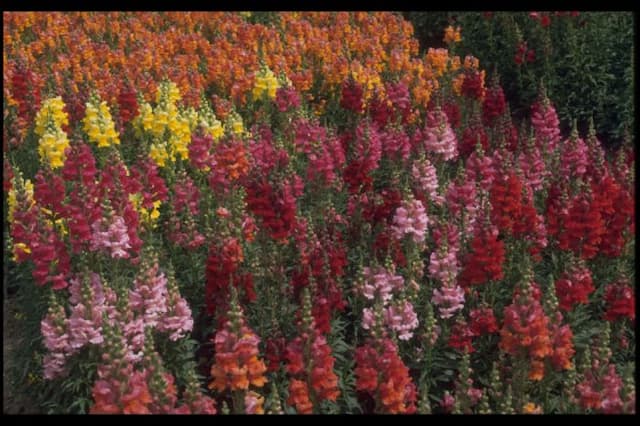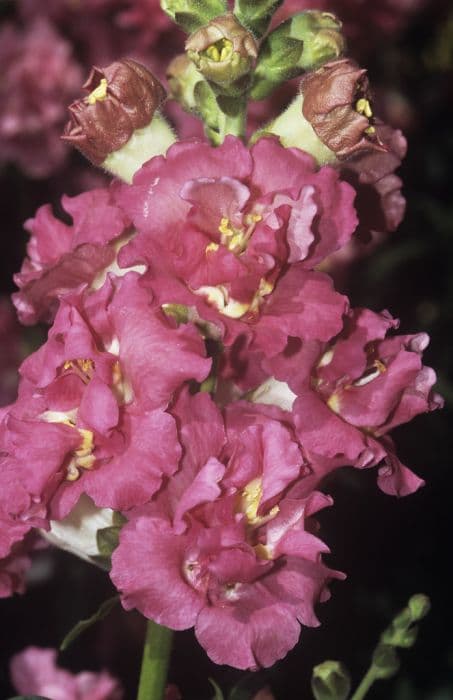Beardtongue Penstemon 'Pensham Dorothy Wilson' (Pensham Series)

ABOUT
Penstemon 'Pensham Dorothy Wilson' is a perennial plant known for its striking bell-shaped flowers and lush foliage. This particular variety showcases blooms that are a deep pink color with subtly white throats, creating a delightful two-tone effect. The flowers are tubular and arranged on tall spires that rise above the foliage, offering a showy display when they bloom. The leaves of the 'Pensham Dorothy Wilson' are also of interest; they are narrow, glossy, and dark green, forming a bushy clump that provides a lush backdrop for the vibrant flowers. The foliage remains attractive throughout the growing season, giving the plant a full and healthy appearance even when it is not in bloom. In terms of its overall look, the 'Pensham Dorothy Wilson' Penstemon has a neat and tidy habit, with a well-rounded shape that makes it a great choice for garden borders or as a specimen plant in mixed beds. The combination of its dramatic flowers and its dense foliage creates a striking contrast and adds a splash of color to any garden setting. The plant blooms in the late spring to summer, offering a long season of interest. The flowers of the 'Pensham Dorothy Wilson' attract pollinators such as bees and hummingbirds, making it not only a beautiful addition to the garden but also beneficial for the local ecosystem.
About this plant
 Names
NamesFamily
Plantaginaceae.
Synonyms
Beardtongue, Penstemon.
Common names
Penstemon 'Pensham Dorothy Wilson'
 Toxicity
ToxicityTo humans
The most common common name for Penstemon 'Pensham Dorothy Wilson' is beardtongue. Beardtongue is generally not considered toxic to humans. There is no well-documented evidence of it causing serious poisoning or harmful effects when touched or ingested. However, it is always advisable to exercise caution and avoid ingesting any part of ornamental plants, as individual reactions can vary.
To pets
Beardtongue, the most common common name for Penstemon 'Pensham Dorothy Wilson', is not known to be toxic to pets such as dogs and cats. It is generally considered a safe plant in gardens where pets may have access. However, it is always recommended to prevent pets from consuming plants, as individual animals may have different sensitivities or allergic reactions.
 Characteristics
CharacteristicsLife cycle
Perennials
Foliage type
Deciduous
Color of leaves
Green
Flower color
Pink
Height
3 feet (91 cm)
Spread
2 feet (61 cm)
Plant type
Herb
Hardiness zones
8
Native area
North America
Benefits
 General Benefits
General Benefits- Attracts Pollinators: The Penstemon 'Pensham Dorothy Wilson' is known for its ability to attract bees, butterflies, and hummingbirds, which are vital for pollination.
- Drought Tolerance: Once established, this plant is drought-tolerant, making it suitable for areas with water restrictions or for gardeners seeking low-water plants.
- Long Blooming Period: This variety of penstemon boasts a long flowering season, often from late spring to early fall, providing extended color and interest in the garden.
- Easy to Grow: The Pensham Series, including 'Dorothy Wilson', is known for being easy to cultivate, requiring minimal maintenance which is great for both beginner and experienced gardeners.
- Landscape Versatility: This plant can be used in a variety of garden settings, including borders, containers, and as part of cottage or wildflower gardens.
- Aesthetic Appeal: With its striking tubular flowers and vibrant colors, it adds visual appeal and can be used to create stunning garden compositions.
- Cold Hardy: Penstemon 'Pensham Dorothy Wilson' is relatively cold hardy, which allows it to survive and thrive in cooler climates where other plants might fail.
- Deer Resistance: This plant is often resistant to deer, which makes it an excellent choice for gardens in areas where deer browsing is a problem.
 Medical Properties
Medical PropertiesThis plant is not used for medical purposes.
 Air-purifying Qualities
Air-purifying QualitiesThis plant is not specifically known for air purifying qualities.
 Other Uses
Other Uses- Art and Craft Inspiration: Featuring a distinctive color palette, Dorothy Wilson can be used as inspiration for painters and textile designers.
- Garden Photography: With its vivid blooms, this plant is perfect for hobbyist photographers to capture the beauty of garden landscapes.
- Garden Design Education: Because of its unique characteristics, Dorothy Wilson is used in horticulture programs to teach garden design and plant pairing.
- Ecological Studies: It provides a case study for students and scientists interested in pollination biology, as it attracts bees and hummingbirds.
- Culinary Decoration: The flowers of Dorothy Wilson can be used to decoratively embellish desserts and drinks when hosting garden parties.
- Beekeeping Attractant: Its flowers can be planted to specifically attract bees for local beekeeping initiatives.
- Companion Planting: Gardeners can utilize Dorothy Wilson in companion planting to enhance the growth of vegetables by attracting beneficial insects.
- Floral Arrangements: Fresh or dried, these flowers are sometimes used in floral arrangements for their shape and color.
- Seasonal Celebrations: The blooms can be used for decoration during specific festivities like spring fairs or garden-themed events.
- Nature-Inspired Crafts: The structure and form of the Dorothy Wilson can inspire eco-friendly craft designs, such as creating flower shapes in fabrics or papers.
Interesting Facts
 Feng Shui
Feng ShuiThe Beardtongue is not used in Feng Shui practice.
 Zodiac Sign Compitability
Zodiac Sign CompitabilityThe Beardtongue is not used in astrology practice.
 Plant Symbolism
Plant Symbolism- Endurance and Strength: Penstemons are known for their tough and hardy nature, able to thrive in harsh conditions, representing the ability to endure and maintain strength through difficult times.
- Attraction and Charm: With their vivid colors and attractive blossoms, Penstemons symbolize the power of attraction and the beauty that draws attention from all around.
- Diversity and Versatility: Coming in various colors and forms, Penstemons represent diversity and the ability to adapt to a wide range of environments and situations.
- Boldness and Daring: The striking appearance of the Penstemon 'Pensham Dorothy Wilson' can be symbolic of a bold and daring spirit, encouraging one to stand out and be unique.
- Health and Vitality: Penstemons are often associated with robust health and vitality, as many species have been traditionally used for their medicinal properties.
 Water
WaterThe Beardtongue should be watered deeply to ensure that the water reaches the root zone, but it must be allowed to dry out between waterings to avoid root rot. During the growing season, watering once a week with about one gallon of water per plant is often sufficient, but this should be adjusted depending on weather conditions and soil type. Always check the top inch of soil for dryness before watering again. In hotter, dryer periods, more frequent watering may be necessary, while in cooler or rainy times, less water is needed.
 Light
LightBeardtongues thrive in full sun to partial shade. They should be planted in a location where they receive at least 6 to 8 hours of sunlight per day to encourage the best growth and flowering. They can tolerate some shade, especially in the hotter parts of the day, but too much shade may result in fewer flowers and leggy growth.
 Temperature
TemperatureBeardtongues prefer a temperature range between 60 to 70 degrees Fahrenheit but can survive in temperatures as low as 20 degrees Fahrenheit and as high as 85 degrees Fahrenheit. They are hardy perennials that can endure a variety of temperature conditions once established, though extreme cold or heat may damage the plant if prolonged.
 Pruning
PruningBeardtongues should be pruned to remove spent flower spikes and to shape the plants. This encourages a second flush of blooms and keeps the plant looking tidy. Deadheading throughout the blooming season can improve the plant's appearance and vigor. After the first killing frost, prune back the foliage to an inch above the ground. This should be done once a year, typically in late fall or early winter.
 Cleaning
CleaningAs needed
 Soil
SoilBeardtongue thrives in well-draining soil with a pH range from neutral to slightly alkaline. A good mix would be loam-based with added perlite or grit for improved drainage. The ideal pH for Penstemon 'Pensham Dorothy Wilson' is between 6.0 and 8.0.
 Repotting
RepottingBeardtongue rarely needs repotting and often prefers to be left undisturbed. However, if necessary, repotting can be done in spring every 2-3 years to refresh the soil or if the plant has outgrown its container.
 Humidity & Misting
Humidity & MistingBeardtongue plants generally prefer low to moderate humidity levels and are quite tolerant of dry conditions. They do well in the average humidity found in most outdoor garden environments.
 Suitable locations
Suitable locationsIndoor
Ensure bright light, minimal water.
Outdoor
Full sun, well-drained soil, water when dry.
Hardiness zone
4-9 USDA
 Life cycle
Life cyclePenstemon 'Pensham Dorothy Wilson' begins its life cycle when seeds germinate in late winter to early spring, with young seedlings emerging in favorable growing conditions of warmth and moisture. As spring progresses, the seedlings develop true leaves and establish a root system, eventually forming a rosette of foliage at the base. The plant enters its vegetative growth phase in late spring to early summer, during which it develops sturdy stems and a bushy form. Flowering occurs in early to mid-summer, with the plant producing tall spikes adorned with tubular flowers that are attractive to pollinators such as bees and hummingbirds. After pollination, the flowers develop into seed capsules, and by late summer or fall, the capsules release seeds, completing the reproductive cycle. As a perennial, Penstemon 'Pensham Dorothy Wilson' will prepare for dormancy in autumn, with the above-ground growth dying back, and the plant surviving winter through its root system before beginning the cycle anew the following spring.
 Propogation
PropogationPropogation time
Spring-Summer
Propogation: The Penstemon 'Pensham Dorothy Wilson', commonly known as beardtongue, is most popularly propagated through stem cuttings. The best time to take stem cuttings is in late spring to early summer when the plant is actively growing. To propagate, choose healthy, non-flowering stems and cut a length of about 4-6 inches (about 10-15 centimeters). Remove the leaves from the bottom half of the cutting and dip the cut end into rooting hormone powder to encourage root growth. Plant the cutting in a well-draining soil mix, ensuring that the soil stays moist but not waterlogged. Place the potted cutting in a warm location with indirect sunlight and keep the environment humid if possible. Roots generally develop within a few weeks, after which the new Penstemon can be gradually acclimated to outdoor conditions before planting it out.





![Snapdragon [Pretty in Pink]](/_next/image?url=https%3A%2F%2Fplants-admin.emdemapps.com%2Fimages%2Fplants%2F%2Fimages%2F604b5cb3b5385.png&w=640&q=75)



